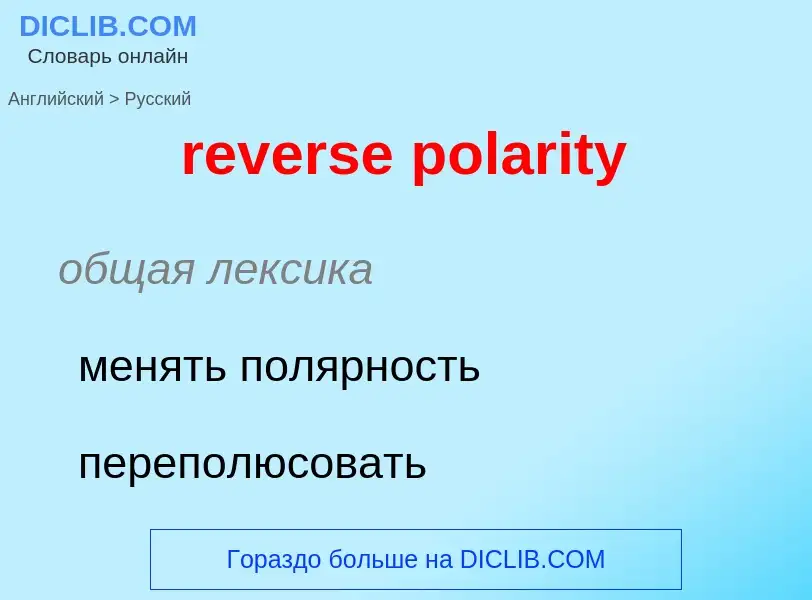Перевод и анализ слов искусственным интеллектом ChatGPT
На этой странице Вы можете получить подробный анализ слова или словосочетания, произведенный с помощью лучшей на сегодняшний день технологии искусственного интеллекта:
- как употребляется слово
- частота употребления
- используется оно чаще в устной или письменной речи
- варианты перевода слова
- примеры употребления (несколько фраз с переводом)
- этимология
reverse polarity - перевод на русский
общая лексика
менять полярность
переполюсовать
общая лексика
неполярная молекула
общая лексика
неполярный
бесполюсный
Определение
Википедия
An electric current is a stream of charged particles, such as electrons or ions, moving through an electrical conductor or space. It is measured as the net rate of flow of electric charge through a surface or into a control volume.: 2 : 622 The moving particles are called charge carriers, which may be one of several types of particles, depending on the conductor. In electric circuits the charge carriers are often electrons moving through a wire. In semiconductors they can be electrons or holes. In an electrolyte the charge carriers are ions, while in plasma, an ionized gas, they are ions and electrons.
The SI unit of electric current is the ampere, or amp, which is the flow of electric charge across a surface at the rate of one coulomb per second. The ampere (symbol: A) is an SI base unit.: 15 Electric current is measured using a device called an ammeter.: 788
Electric currents create magnetic fields, which are used in motors, generators, inductors, and transformers. In ordinary conductors, they cause Joule heating, which creates light in incandescent light bulbs. Time-varying currents emit electromagnetic waves, which are used in telecommunications to broadcast information.

![Alternating electric current flows through the solenoid, producing a changing magnetic field. This field causes an electric current to flow in the wire loop by [[electromagnetic induction]]. Alternating electric current flows through the solenoid, producing a changing magnetic field. This field causes an electric current to flow in the wire loop by [[electromagnetic induction]].](https://commons.wikimedia.org/wiki/Special:FilePath/Electromagnetic induction - solenoid to loop - animation.gif?width=200)
![Magnetic field is produced by an electric current in a [[solenoid]]. Magnetic field is produced by an electric current in a [[solenoid]].](https://commons.wikimedia.org/wiki/Special:FilePath/Magnetic field produced by an electric current in a solenoid.png?width=200)


![In a molecule of [[boron trifluoride]], the trigonal planar arrangement of three polar bonds results in no overall dipole. In a molecule of [[boron trifluoride]], the trigonal planar arrangement of three polar bonds results in no overall dipole.](https://commons.wikimedia.org/wiki/Special:FilePath/Boron-trifluoride-elpot-3D-vdW.png?width=200)


![In [[methane]], the bonds are arranged symmetrically (in a tetrahedral arrangement) so there is no overall dipole. In [[methane]], the bonds are arranged symmetrically (in a tetrahedral arrangement) so there is no overall dipole.](https://commons.wikimedia.org/wiki/Special:FilePath/Methane-CRC-MW-3D-balls.png?width=200)

![This amphiphilic molecule has several polar groups ([[hydrophilic]], ''water-loving'') on the right side and a long nonpolar chain ([[lipophilic]], ''fat-loving'') at the left side. This gives it [[surfactant]] properties This amphiphilic molecule has several polar groups ([[hydrophilic]], ''water-loving'') on the right side and a long nonpolar chain ([[lipophilic]], ''fat-loving'') at the left side. This gives it [[surfactant]] properties](https://commons.wikimedia.org/wiki/Special:FilePath/CHCA cleavable detergent.png?width=200)
![[[Phospholipid]]s are effective natural surfactants that have important biological functions [[Phospholipid]]s are effective natural surfactants that have important biological functions](https://commons.wikimedia.org/wiki/Special:FilePath/Phospholipid schematic representation.png?width=200)
